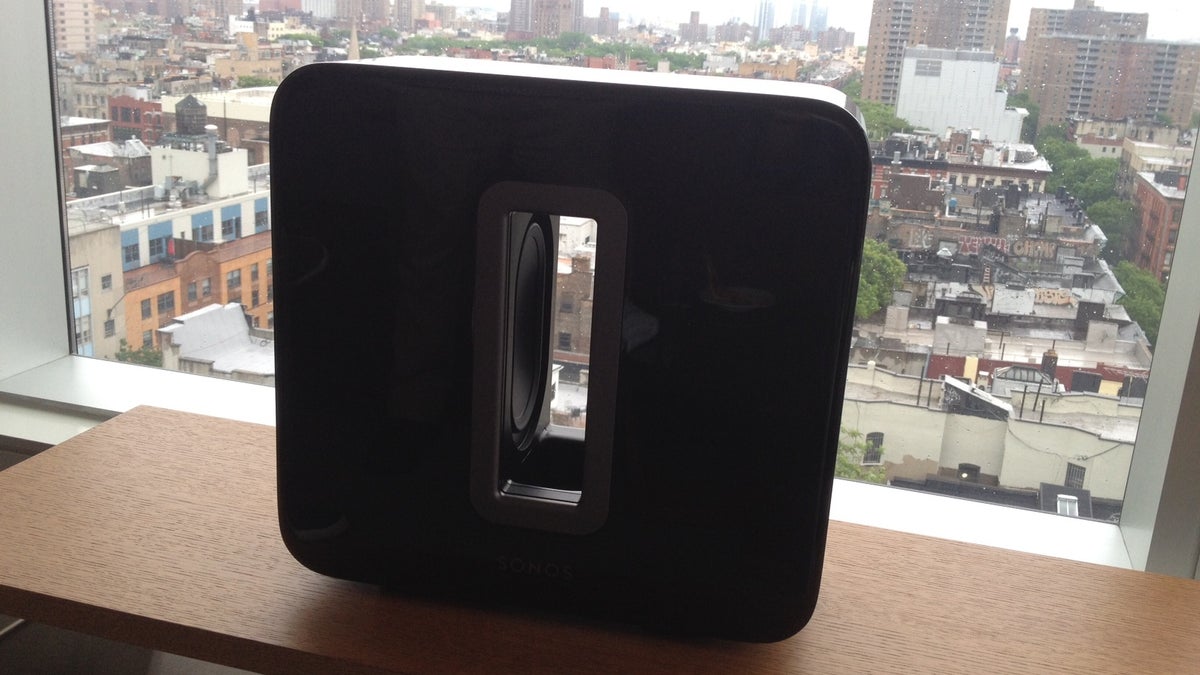Sonos adds striking subwoofer to its lineup of wireless speakers
The company, a leader in multi-room wireless audio, is going upscale with a stylish subwoofer that retails for $699 and delivers booming bass.
If you ever thought the Sonos
As you might gather from its name, this is a subwoofer, and it has a rather striking, modern design that fit right in at the hipster Cooper Square Hotel in New York's NoHo district where Sonos was demoing the product yesterday for the press. That design and its high-gloss lacquered finish come at a fairly steep price: when it goes on sale in June, the Sonos Sub will retail for $699 ($749 CAD, $999 AUD, 699, and £599). If you can wait till October, the same speaker in a black matte finish will be available for $599 USD ($649 CAD, $899 AUD, 599, and £499).
In case you don't know what Sonos is, the company makes multi-room wireless audio systems that cost a fraction of what home installers will charge you to wire up your house with speakers and a control panel. You can operate the system via your computer or a free app on iOS and Android mobile devices (Sonos was using the iPad for the demo). It's also worth noting that the Sub works with all Sonos amplified components: Connect:Amp/ZonePlayer 120/ZonePlayer 100; Play:5; Play:3. However, it does not work with the non-amplified Sonos Connect/ZP90/ZP80.
The demo was pretty impressive. When the Sub's integrated into your system, it automatically adjusts its sound according to what speakers you're using. For the demo, Sonos reps used two of the smaller $299 Play:3 units to form stereo "front" speakers with the sub positioned between them on a table.
With all the bass going to the sub woofer, the smaller Play: 3, which has its low-end limitations, can concentrate on putting out sound frequencies in the sweet spot of its range. Using the sub set-up menu in the Sonos app, it's easy to adjust the bass levels according to the type of room you're in and where you place the Sub in the room.
The system I heard would would cost $1350 (with a Zone Bridge), which made me wonder whether I could get a receiver, a pair of speakers, and a standard sub for a similar price (or less) that sounded better.
The short answer is yes. But the system wouldn't be an expandable and flexible wireless multi-room system. The point here is that you can plug each speaker into a wall socket and not have to worry about running speaker wire between those speakers. You do need to plug each speaker in and power it, so that may somewhat limit your placement options. Currently, no Sonos speakers are battery powered.
For the demo we were in a relatively small room and were easily overwhelmed with wall-rattling bass once the volume was cranked. I pity the hotel guests on the floor below us -- or four floors down and two rooms to the left (you never know exactly where bass is going to travel). But even with all the vibration you seeing going on inside the speaker, Sonos reps said that the cabinet will not buzz or rattle, thanks to the face-to-face positioning of the two "force-cancelling speakers" inside the unit. They also noted that the cabinet is made from proprietary resin to create "acoustically dead walls with maximum internal air volume."
After the demo was finished, my first thought was that this seemed like a logical move for the company. Both editor John Falcone and I would like to see a Sonos Soundbar and a portable speaker you could take outside, but company reps had hinted to us last year that a subwoofer was first on the agenda, as they were going to make a concerted effort to take the music up a notch, so to speak.
Sonos customers have always been able to incorporate their own high-quality speakers using the Connect:Amp/ZonePlayer 120/ZonePlayer 100 or add a Sonos Connect/ZP90/ZP80 to an existing AV receiver. But the Play:5 and Play:3 speakers, which include an amp and wireless component, are the big sellers today and the driving force behind the company's recent growth. However, as I said in the intro, those speakers have their limitations, so giving customers the option to augment their sound in a serious way makes perfect sense.
Of course, for some $699 is a lot to pay to get to the next level. But at least the option's there, though apparently Scandinavians and this writer are already asking when a white model will show up (sorry, no word on that yet).
As for when we'll have a full review of the Sub, we should be getting a review unit into our audio room in the next few weeks and will put it through its paces before it ships on June 15. In the meantime, have a look at this video:


